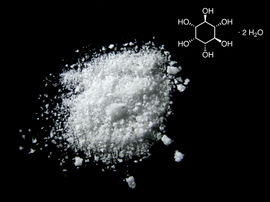Difference between revisions of "Inositol"
Diachrynic (Talk | contribs) |
|||
| (One intermediate revision by one other user not shown) | |||
| Line 7: | Line 7: | ||
| OtherNames = cis-1,2,3,5-trans-4,6-Cyclohexanehexol<br>Cyclohexanehexol<br>Mouse antialopecia factor<br>Nucite<br>Phaseomannite<br>Phaseomannitol | | OtherNames = cis-1,2,3,5-trans-4,6-Cyclohexanehexol<br>Cyclohexanehexol<br>Mouse antialopecia factor<br>Nucite<br>Phaseomannite<br>Phaseomannitol | ||
<!-- Images --> | <!-- Images --> | ||
| − | | ImageFile = | + | | ImageFile = Myo_Inositol.jpg |
| − | | ImageSize = | + | | ImageSize = 270px |
| ImageAlt = | | ImageAlt = | ||
| ImageName = | | ImageName = | ||
| Line 51: | Line 51: | ||
| BoilingPtC = | | BoilingPtC = | ||
| BoilingPt_ref = | | BoilingPt_ref = | ||
| − | | BoilingPt_notes = | + | | BoilingPt_notes = Decomposes |
| Density = 1.752 g/cm<sup>3</sup> | | Density = 1.752 g/cm<sup>3</sup> | ||
| Formula = C<sub>6</sub>H<sub>12</sub>O<sub>6</sub> | | Formula = C<sub>6</sub>H<sub>12</sub>O<sub>6</sub> | ||
| Line 64: | Line 64: | ||
| pKa = | | pKa = | ||
| pKb = | | pKb = | ||
| − | | Solubility = 14 g/100 ml (25 ºC) | + | | Solubility = 14 g/100 ml (25 ºC), <br/> 28 g/100 mL (60 °C)<ref>W.L.F. Armarego, C.L.L. Chai, Purification of Laboratory Chemicals (Sixth Edition), |
| − | | SolubleOther = Moderate soluble in [[methanol]]<br>Slightly soluble in [[Dimethyl sulfoxide|DMSO]]<br>Insoluble in alcohols, [[dichloromethane]], [[dimethylformamide]], [[tetrahydrofuran]]<ref>https://www.researchgate.net/post/Does_anyone_know_about_solubility_of_Inositol_except_for_water</ref> | + | Butterworth-Heinemann, 2009, ISBN 9781856175678, p. 693</ref> |
| + | | SolubleOther = Moderate soluble in [[methanol]]<br>Slightly soluble in [[Dimethyl sulfoxide|DMSO]], [[ethanol]]<br>Insoluble in alcohols, [[dichloromethane]], [[dimethylformamide]], [[tetrahydrofuran]]<ref>https://www.researchgate.net/post/Does_anyone_know_about_solubility_of_Inositol_except_for_water</ref>, [[diethyl ether]]<ref>W.L.F. Armarego, C.L.L. Chai, Purification of Laboratory Chemicals (Sixth Edition), | ||
| + | Butterworth-Heinemann, 2009, ISBN 9781856175678, p. 693</ref> | ||
| Solvent = | | Solvent = | ||
| VaporPressure = ~0 mmHg | | VaporPressure = ~0 mmHg | ||
| Line 115: | Line 117: | ||
Oxidation with nitric acid gives rhodizonic acid. | Oxidation with nitric acid gives rhodizonic acid. | ||
| + | |||
| + | Inositol may be recrystallized from water or 50% ethanol/water, from which a dihydrate results. It may be dehydrated to a non-hygroscopic anhydrous form.<ref>W.L.F. Armarego, C.L.L. Chai, Purification of Laboratory Chemicals (Sixth Edition), | ||
| + | Butterworth-Heinemann, 2009, ISBN 9781856175678, p. 692</ref> | ||
===Physical=== | ===Physical=== | ||
| Line 120: | Line 125: | ||
==Availability== | ==Availability== | ||
| − | Inositol is available in many health food stores. | + | Inositol is available in many health food stores. It is sold as a food supplement, sometimes mixed with taurine. |
It can also be bought online cheaply. | It can also be bought online cheaply. | ||
Latest revision as of 21:41, 27 February 2021

| |
| Names | |
|---|---|
| IUPAC name
(1R,2R,3S,4S,5R,6S)-cyclohexane-1,2,3,4,5,6-hexol
| |
| Other names
cis-1,2,3,5-trans-4,6-Cyclohexanehexol
Cyclohexanehexol Mouse antialopecia factor Nucite Phaseomannite Phaseomannitol | |
| Properties | |
| C6H12O6 | |
| Molar mass | 180.16 g/mol |
| Appearance | White solid |
| Odor | Odorless |
| Density | 1.752 g/cm3 |
| Melting point | 225–227 °C (437–441 °F; 498–500 K) |
| Boiling point | Decomposes |
| 14 g/100 ml (25 ºC), 28 g/100 mL (60 °C)[1] | |
| Solubility | Moderate soluble in methanol Slightly soluble in DMSO, ethanol Insoluble in alcohols, dichloromethane, dimethylformamide, tetrahydrofuran[2], diethyl ether[3] |
| Vapor pressure | ~0 mmHg |
| Hazards | |
| Safety data sheet | Sigma-Aldrich (myo-inositol) |
| Flash point | 143 °C |
| Lethal dose or concentration (LD, LC): | |
| LD50 (Median dose)
|
10,000 mg/kg (mouse, oral) |
| Except where otherwise noted, data are given for materials in their standard state (at 25 °C [77 °F], 100 kPa). | |
| Infobox references | |
Inositol or cyclohexane-1,2,3,4,5,6-hexol is a chemical compound with formula C6H12O6, a sugar alcohol. It exists in nine possible stereoisomers, of which the most prominent form, widely occurring in nature, is cis-1,2,3,5-trans-4,6-cyclohexanehexol, or myo-inositol (former names meso-inositol or i-inositol). Its taste has been assayed at half the sweetness of table sugar (sucrose).
Contents
Properties
Chemical
Inositol can be nitrated to give inositol hexanitrate using a nitrating mixture.
Oxidation with nitric acid gives rhodizonic acid.
Inositol may be recrystallized from water or 50% ethanol/water, from which a dihydrate results. It may be dehydrated to a non-hygroscopic anhydrous form.[4]
Physical
Inositol is a crystalline solid, soluble in water.
Availability
Inositol is available in many health food stores. It is sold as a food supplement, sometimes mixed with taurine.
It can also be bought online cheaply.
Preparation
Inositol is best bought than made.
Projects
- Make rhodizonic acid and potassium rhodizonate
- Make inositol hexanitrate
Handling
Safety
Inositol has low toxicity and it's 100% edible. Lab-grade inositol however, isn't.
Storage
Inositol should be kept in closed bottles, plastic bottles are sufficient.
Disposal
Inositol doesn't require special disposal. Discard it as you wish.
References
- ↑ W.L.F. Armarego, C.L.L. Chai, Purification of Laboratory Chemicals (Sixth Edition), Butterworth-Heinemann, 2009, ISBN 9781856175678, p. 693
- ↑ https://www.researchgate.net/post/Does_anyone_know_about_solubility_of_Inositol_except_for_water
- ↑ W.L.F. Armarego, C.L.L. Chai, Purification of Laboratory Chemicals (Sixth Edition), Butterworth-Heinemann, 2009, ISBN 9781856175678, p. 693
- ↑ W.L.F. Armarego, C.L.L. Chai, Purification of Laboratory Chemicals (Sixth Edition), Butterworth-Heinemann, 2009, ISBN 9781856175678, p. 692